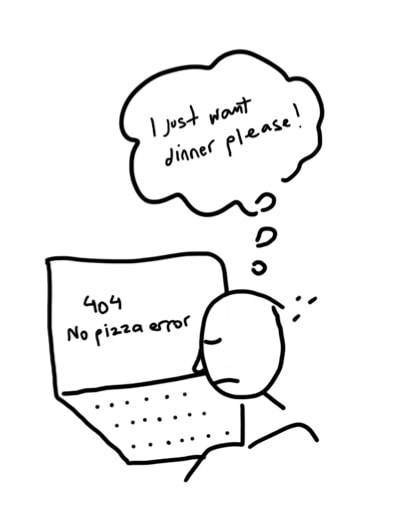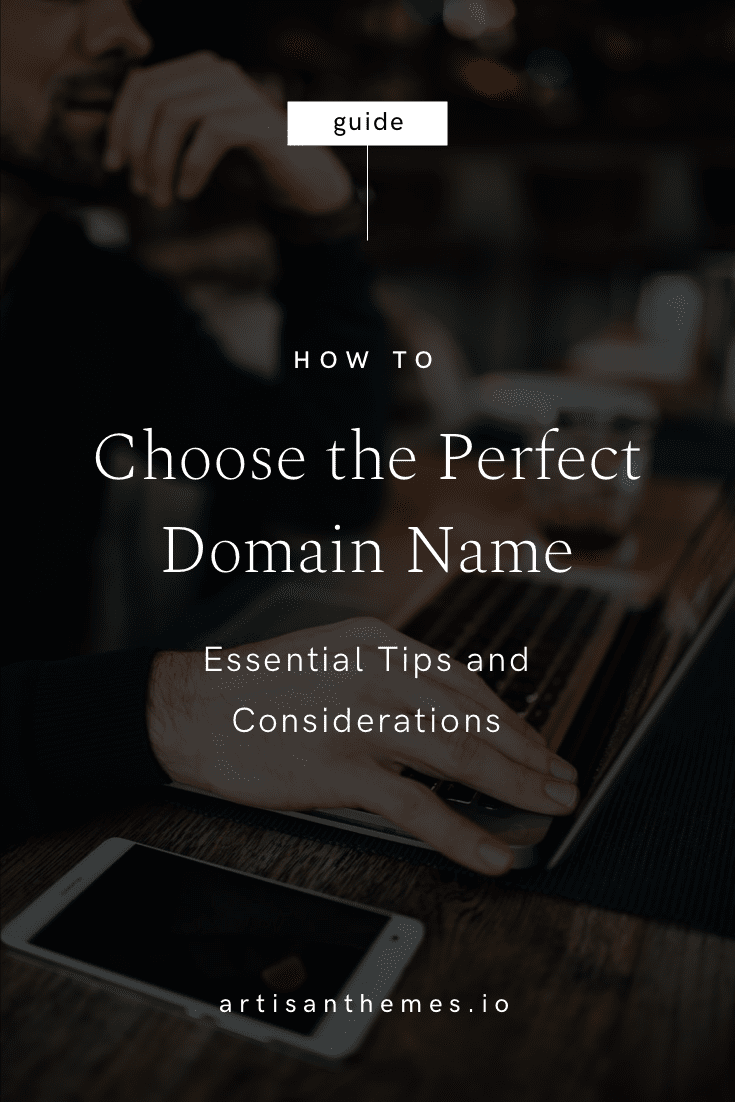What’s exactly a domain?
Just so we are on the same page before we dig into choosing the perfect domain for your website, let’s go over some basic concepts.
It’s going to get pseudo-technical for a couple of paragraphs, but bear with me, it’ll be worth it.
A domain name is the unique and specific address of your website. It’s what your visitors will type in their browsers in order to get to your site. And it’s the base address for everything that’s going to be up in your site.
So what’s the difference between a domain and a URL? The URL is the whole address that shows up in your browser’s navigation bar, including what comes before and what comes after the domain.
Domain:
example.com
URL:
https://example.com/about
Subdomain
As simple as it sounds, a subdomain is a domain that’s part of a larger domain. The subdomain will come before the domain, separated by a dot.
Subdomain:
something.example.com
It’s usually used when you want to create a different website under the same domain. A good example would be different departments of the same university, where each one has its own independent website.
You might not use subdomains ever, but the important thing here is understanding that something.example.com is still under the example.com domain. Once you own a domain you can create any subdomains you want, but you can’t use something.example.com if you don’t own example.com first.
Top-Level Domain (TLD) and why you should care about it
Every domain finishes with a specific extension. The term TLD refers to that last part of your domain.
Each country has its own available TLD, like .uk (United Kingdom), .de (Germany), .it (Italy), .es (Spain) or .cl (Chile).
But there are also TLDs for different types of websites, like .org for organizations, .edu for educational institutions, .gov for government entities or .com for commercial sites.
These can be combined with the country code top-level domains. E.g. If you’re building a website for an NGO located in Colombia, you will probably choose a domain ending with .org.co.
That said, you’re not obligated to use your country code top-level domain. You can run your website from France and still use a domain ending with just .com. More on this below.
Now, you probably saw TLDs such as .design, .club, .life, .store, .pizza. That’s because the ICANN (the Internet Corporation for Assigned Names and Numbers) periodically releases new TLDs to the public. And while these may sound pretty cool, most of the times a typical .com will be probably the best extension to go with.
That’s mainly for 2 reasons:
- People are used to type .com at the end of a website address. If you happen to choose a domain like romanos.pizza, and they accidentally write romanos.pizza.com, romanospizza.com or romanos.com, they won’t find your website. Or even worst: they’ll arrive to a 404 error page on somebody else’s website because of the subdomain thing. Remember romanos.pizza.com is actually a subdomain of the pizza.com domain. Tricky, uh?
- The second reason is credibility: .com looks more trust worthy than .click.
But it’ll actually depend on your type of business. Sometimes you’ll be fine playing with a fun TLD while other times you may need a more conventional domain extension.
You can read the full list of TLDs available here.
Why is it so important to choose the right domain for your website?
First impression
A domain is not just a technical part of your website, it’s actually a key component of your online brand.
Your domain name is one of the first things your audience will get in touch with when they interact with your website.
Whether they manually type it in the browser or whether they go to your site by clicking on a link, your website’s address is one of the first things they’ll see when they arrive to it.
And that address can affect the first impression your audience gets from your brand.
Will they know right away they’ve arrived to a good place?
Will that web address make them feel they can trust your website?
Will that web address be easy to read?
Will they remember it?
Will it sound familiar when they visit your site again?
You want to choose a domain name that will have you answering YES to as many of these questions as possible.
Trust and legitimacy
Your website’s domain is one of the first factors that helps establishing trust. The whole domain, and that includes the TLD you choose, will affect how your audience perceives your site.
Now, you might assume people don’t even look at the domain of a website, but think about this: it’ll be right there at the scene when you share a post on social media, or when your website appears on Google’s results.
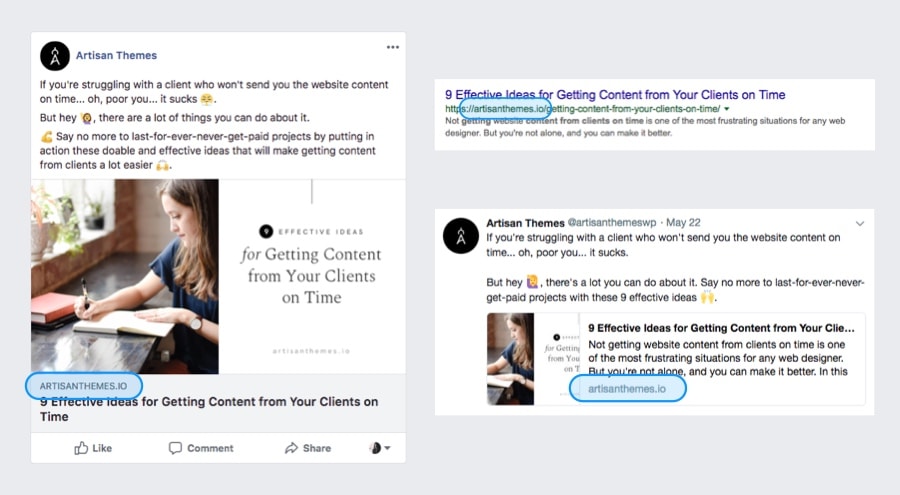
Your domain on search results and social media
Your domain tells all of us where that piece of information comes from, and while doing that, it legitimates or delegitimates the information. Therefore, your domain will influence people’s willingness to click on it or keep scrolling.
Imagine being shared a piece of important news coming from the domain ‘jokeisonyou.com’. It makes you wonder, right?
So when you choose your domain name, ask yourself: Does the domain I’m choosing help me build trust and legitimacy?.
It’s not something you’ll change anytime soon
We’ll talk about this in a few minutes, but this is an important reason you’ll want to take your time for picking the right domain.
The best analogy I can think of is that when you choose a domain, you’re not renting a hotel room for the holidays but more like buying a house to start raising a family.
(Actually, I have tons of food-related metaphors probably because I’m hungry now, but the hotel’s one was way more accurate.)
The thing is you’ll start building your brand together with that domain name, and that’s not something you’ll change every moon. You’ll stick to it because brands are made over time.
I’m not saying you can’t start over if you find out things have changed or you come up with a better domain name idea. But that’s not without a price: the price of moving your website to a new domain and start building your website’s reputation again, and –what’s more important– without losing what you’ve built brand-wise with the first name.
So… to help you choose the perfect domain name for your website, here’s all you need to know and consider. And don’t be afraid if the process of picking the right domain takes days or even weeks, that’s absolutely normal.
Considerations for choosing the right domain name
→ Branding
For the reasons I told you earlier, branding is one of the main factors you should consider when choosing your domain name.
You want your domain name to sound like the name of a brand and not just like a name of any other website.
In that sense, a brandable domain name will be:
- Unique – Will sound like a unique name and not a generic one. For example, familiytreeonline.com sounds very generic and not like a brand at all. Coming up with a unique and creative word, even if it’s made up, will make it more brandable: geni.com.
- Recognizable – If you’re in a social gathering and somebody asks your friend where did he create his online family tree, he’ll say at the “online family tree -or something- website”. And you’ll say “hey, I’ve used that website too”. But actually, he created it at onlinefamtree.com and you did it at bestfamilytree.com. These types of domain names aren’t differentiable at all, therefore they lack recognition. If you want to build a strong brand, make sure the name sounds recognizable and different enough from other brands or websites.
- Memorable – A unique and recognizable name that sounds and reads nicely will be much more memorable than a non-brandable name. geni.com you’ll remember, but you wouldn’t remember it if it was familytree.com, familyonlinetree.com, or onlinefamilytree.com. A memorable name is usually shorter, with no more than 2 words (or so) together.
[quick-note]
Don’t get me wrong, I don’t think a domain like onlinefamilytree.com is bad per se, it’s just not suitable for all kinds of websites. For example, if you’re in the affiliate marketing business, and you’re building a reviews site about kitchen supplies, and you don’t care about building a brand but just about sending traffic through clicks on your site’s posts, then it might not matter if your domain is unique, recognizable and memorable. But if you care about building a brand around your website OR building a website for your brand, then you should care about choosing a brandable domain name.
[/quick-note]
Now, if you’re about to choose a domain name for your website I’m sure you’re in one of these 3 scenarios right now:
1. You already have a name for your brand but not a domain name
Your brand already exists, so you’re looking for the right domain for its website. In this case, you’ll try to find a domain that is as close as possible to your brand name.
Let’s say you own a baby clothes brand named Pitzi.
The first you’ll do is look for pitzi.com. If it’s available, invite your family over, open a bottle of champagne and celebrate. You’re a lucky person.
Wait, no.
Before you do that, purchase the domain. Don’t play with luck and let somebody else take it before you do. Then celebrate.
What if pitzi.com is not available? First, don’t panic.
You can’t come up with a completely different domain name here because, well, if your brand is already established, you won’t change its name just because the domain is not available.
There are many things you can do, though:
a. Check if that domain has an actual live website. Sometimes domains are taken but the owners don’t make use of it. If there isn’t a site, and having the pitzi.com is really important to you, you could consider the possibility of buying the domain from the current owner.
The current owner may want to take more money than the regular cost of a domain, so it’s up to you if you’re willing to pay the cost of having the ideal domain. If you’re Airbnb, you will probably do that, but you have also other options.
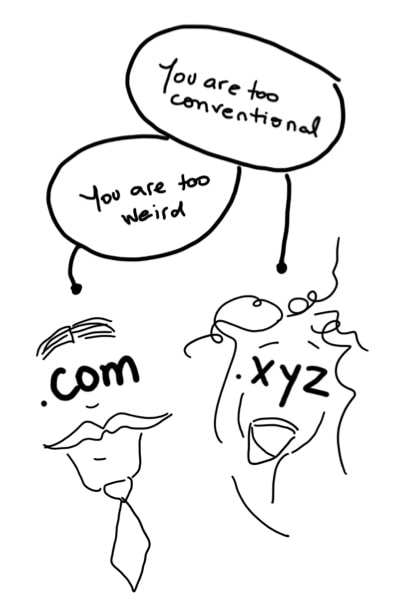
c. Consider adding a second word in your domain, like pitziclothes.com, pitzigarment.com, pitzibaby.com or pitzibabies.com. And give that second word a serious thought. Even if that word is not the part of the actual name of your brand it’s going to be part of it.
It should also be a word that will let you grow as a business without being tied to it.
If you’re only selling baby pants now, you may consider choosing a domain like pitzipants.com. But if you think there’s a chance you’ll also make t-shirts and skirts, and whatever other little cute stuff babies wear, then having “pants” on the domain may will be a limiting choice.
What’s more important: don’t add more than one extra word and avoid using words that will just hurt your brand like pitziweb.com (again, more on this in a few minutes).
2. You’re simultaneously naming your brand and your domain name
This is the ideal situation: you’re now brainstorming names for your brand, so you can simultaneously check if the names you come up with are also available as web domains.
You are not tied to any name and you can discard names that aren’t available.
If you happen to come up with a brilliant idea and the .com is taken, you can approach the selection of your domain with the same guides proposed in the previous scenario (a different TLD, adding a second word, buying from the current owner).
But since you have the possibility to choose a different name, one that hasn’t been used yet at all, maybe it’s best that you go with a different option. One that’s 100% yours, available and unique.
3. You’re considering using your own name
Naming your business after you is definitely a possibility. There are many pros and cons of using your own name for your business. In what matters to the domain name, good news is that it will probably be available.
In any way, choosing to use your own name as your domain name is a question of marketing and business strategy. And, while it could be a great choice, you should think about it carefully.
Here are some of the things you may want to consider:
- Personal vs. Impersonal – Would you like to position your brand as something personal or rather as a more impersonal entity? Your brand can still feel personal and close to people without using your name as the brand name. Using your name means you’ll build your business upon you as a personality. While that’s great for today’s business environment, it might don’t be suitable for everybody or every business.
- Memorability – Is your name memorable? Is your name easy to say and type?
- Experience and value – Are you an expert? Are you just getting started? Do people know you? Is your name going to bring value to building your business right now?
- Prices – Using your name in different industries may affect how much you can charge for your services, positively and negatively. How will it affect prices in your particular situation?
- The future – How do you see the future of your business? Will having your name as your brand’s name still be a good fit then?
→ SEO & Keywords
You might think that your site’s searchability relies on having a keyword-stuffed domain name. But while having a keyword in your domain may help your site’s SEO, that’s not the only thing that will make your site rank high in search engines.
So don’t panic if you find it hard to insert a keyword in your domain name. You don’t necessarily have to. More than that, if your priority is to build a brand, don’t base your business name decision on keywords. You’ll have plenty of other tools to work on your site’s SEO besides the domain.
From a branding point of view, a domain that’s only made of keywords can look too generic and even suspicious.
Would you trust a travel insurance company whose domain is bestinternationaltravelinsurance.com?
Or would you buy tickets to Africa from cheapticketstoafricaonline.com?
I’m not saying SEO is not important, but SEO relies on many factors. One of those is the quality of what’s inside your website, how valuable it is for your audience. And that doesn’t only depend on the domain you choose.
So ask yourself if your priority is to have a brandable domain name or a keyword domain name. The answer depends on the kind of website and business you’re choosing the domain for.
→ Location
Is your business’ audience worldwide or local?
If you have a local hair salon in Brazil, you may want your domain to use the .br TLD. The country code extension will immediately let your visitors know where your business is located, so they’ll know if it’s relevant to them or not.
If you’re not specifically marketing your business’ physical location, then it’s better to use a generic TLD so you don’t exclude visitors by making them believe your website is not relevant to them because they live somewhere else.
→ Availability
It might sound obvious, but for you to be able to purchase a domain, it should be available. In other words, it shouldn’t be in use or registered by somebody else.
But availability is not only about the actual domain name not-being-taken for purchase.
Check availability in social media platforms
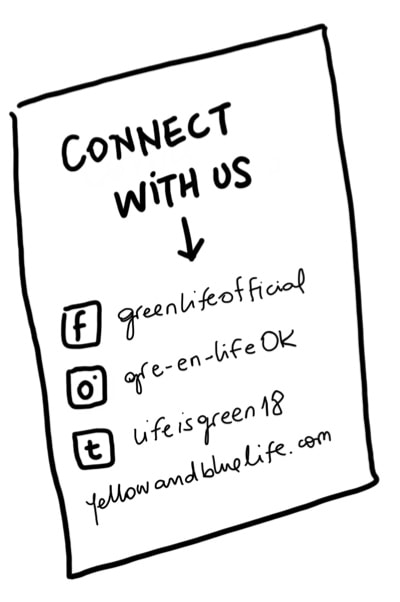
That will help your brand get stronger and memorable, and also avoid sending visitors and prospects to the wrong places.
Imagine purchasing the domain greenlife.com for an ecological project just to find out after the fact that there’s already a page on Facebook called “Green Life” about 45+ year olds living an immature teenage life.
And that’s what visitors will find first when they lookup for your name on Facebook.
So before you purchase your domain, check that social media handles with the same name are available too on the social media channels you’re gonna use.
Watch out for trademark infringement
So you came up with an awesome domain name all by yourself… but wait, maybe someone else already came up with the same name for a product and not only that but they also registered it as a trademark.
Avoid legal issues by checking if your name is already registered or in use by somebody else.
Also, beware of trademarked names as part of your name, like getamacbookpro.com.
The process:
Brainstorm » Research » Decide
Coming up with a name
Conducting a good old fashion brainstorming session will be a productive starting point.
Brainstorming is about generating as many ideas as you can about a subject, without making any decisions yet. For a brainstorming to be any good you should play by these rules:
- Set a clear purpose
- Quantity is more important than quality
- Don’t say no to any idea, you never know which idea will bring up a good name
- Don’t be afraid to go crazy
- Don’t judge
- Stay focused, don’t start talking about something else
- Write everything down
If you have a friend at hand or can gather a small group of people to brainstorm with you, it’ll be even more fun and prolific.
You can try a variation of the classic Brainstorming by gathering a group of 4 to 6 people and make everyone say a word based on the previously mentioned word. So instead of throwing unrelated ideas in an illogical order, each idea should be based on the previous one.
You can also try other creative techniques to generate ideas. I like using two specific ones that really help coming up with new and creative names:
1. Fantastic binomial
The idea is to put together two words that aren’t related at all and generate a new unique idea based on the two unassociated words.
You can start by taking a base word that’s related to your business (e.g. Coffee) and look for words from different worlds to put together with the base word. Like an animal, an everyday object, a geographical concept, a musical concept, a mathematics term, an idiom, etc.
Try different combinations and see what comes up.
2. Attribute listing
This technique is usually used to improve products or services, but you can also take its logic to come up with an idea for a domain name.
Open a new doc and list all the attributes of your product/service. Don’t leave anything out. Write down every physical or abstract characteristic of your business’ components.
When you finish, go over the attributes listed and mark the ones that you think represent the core of your brand.
Then think if you can use them to come up with an idea for a name, by putting the word together with a different one, by twisting the word a little, by translating it to a different language, etc.
——
If these techniques don’t get you going, you can also try different name generation tools such as these:
Lean Domain Search – leandomainsearch.com
Name Mesh – namemesh.com
Panabee – panabee.com
Researching the candidates
Once you have a list of a few potential ideas, it’s time to look for availability.
You can check if your domain is available when searching it at your domain registrar (more on this soon) or in a website like Knowem, which will let you check for your name with different TLD options and over most popular social media sites.
(As we talked before, remember to also check for social media handles and trademarked names.)
Make a table with your domain candidates and write down next to each one whether it’s available or not, which TLDs are available, if there are variations you can use, if there are already social media handles using similar names, etc.
Making the final checks and getting married to your domain
You have a great idea for a domain name, you checked it’s indeed available and you’re ready to commit.
Most domains are pretty cheap (around $10/year), so there’s no much to think about it. If you see a domain name that you want and it’s available –even if you’re not yet 100% sure you’re gonna use it– and you have the money, purchase it. It’ll just assure you nobody else will take it from you.
But before you decide to use it, you may want to pass your domain through a final test.
Final Test & Tips
✓ Easy to type and say
Ok, so my last name is Knoblovits. Which is a last name from Hungary, pretty much impossible to pronounce here in Latin America.
Every time I register for an event or sign up for a new dance class, I have to spell it letter by letter.
I start saying “K – N …”
Right at this point I see them writing “Kan” (because they can’t believe there isn’t a vowel between the K and the N), so I stop and explain: “No, no, it’s K – N together, there’s no vowel in between”.
They strike the vowel and I keep spelling “… O – B – L”.
And by the time I get to the second “O” they always think I’m finished and ask for the next detail.

– “Oh, no, no, there are still 4 letters to go…”
– (Comes back to the previous checkbox and continues writing in the 0.5 mm left)
– “… V – I – T – S”
– “T – Z?”
– “No, T – S”
And when we’re finished they take a deep breath like they’ve just run a long marathon.
And of course, they try to say it out loud and they fail to pronounce it right.
I’m used to it and I laugh about it.
But imagine going through this every time you have to say your website’s address to someone.
Trust me, nobody deserves that.
So pick a domain that’s not tricky, that’s easy to pronounce and type.
Ask yourself “Can I say it in a party and have people understand it?”. And choose a domain that will answer positively to that question.
✓ Concise
The definition of concise is: brief but comprehensive. That’s what a perfect domain name should be, as short as possible but as clear and complete as possible too.
In short, say what you have to say with the fewer possible words.
Choosing a domain that’s too long will make it harder for people to type, to read, to recognize and to memorize.
On the other hand, that doesn’t mean it should be an abbreviation of your brand’s name or that you should use u instead of you or 4 to say four.
Keep it short but clear and intuitive too.
✓ Timeless
A domain name it’s not something you change every year. On the contrary, it’s going to be one of the most steady elements of your brand (unless you decide to rename your brand, of course).
Once you begin using your domain and building your website on top of it, your domain starts having a sort of an online record. And that’s something you want to cultivate over time.
Besides, moving to a new domain means a lot of work and building your domain reputation all over again.
So you may want to avoid introducing elements that will make your domain less future proof, such as dates or trendy words.
If you’re organizing an event for sourdough lovers in Rome, you may be tempted to choose a domain like romesourdough2019.com. But this event may have more editions in the future, so it’s better to pick romesourdough.com. And if you’ll want a different website for each edition, maybe put each one on a subdomain: 2019.romesourdough.com.
Even more… what if you go globally in a few years and export this event to other countries? In that case, maybe sourdoughconf.com will be best. And then each country on a subdomain may be the way to go.
Although, again, consider everything. If your event is indeed in Rome and you plan to stay there, having the word Rome in it is a great kickstarting point.
You can’t be sure of what the future is going to bring, but you can think your domain in a sustainable way as much as possible.
Just stop for a second and think if it’s going to be relevant a few years from now and how you can make it more futureproof.
✓ Avoid using hyphens or odd characters
It’s better to put words together than separate them with a hyphen. People are used to write only letters to get to a website, they won’t know you decided to separate the words of your brand’s name with hyphens.
Plus, it’s way more intuitive and it also looks much nicer to the eye:
mybrand.com vs. my-brand.com
If you’re considering using a hyphen because the domain without it is taken, then it’s even less advisable. You’ll be like voluntarily sending people to that other website.
✓ Avoid these ugly practices
I had a client many years ago who owned a pet shop called Mascotas. Because the mascotas.com domain was apparently unavailable, he decided he would add the word “web” to the domain. So he purchased mascotasweb.com.
(That was before he hired me, of course :))
You see the ugly practice here, do you? There’s no need to add the word “web” to your WEBSITE address. Believe me, by now people are already aware they are entering a website when they open their browsers and type an address… you don’t have to tell them that’s your web.
You won’t probably add the word “instagram” at the end of your Instagram handle or “Facebook Page” at the end of your Facebook Page name.
And as for Google, keep calm. They do too know your website is a website.
It actually does more damage to your brand than it helps it. It says you don’t get the web at all.
So please, don’t ever add these words to your domain if they are not part of your brand’s name just because the domain you wanted wasn’t available:
web
website
ok
online
portal
Remember your domain is a huge part of your brand, you don’t toy with it.
✓ Consider buying other TLD versions and commonly misspelled versions too
If you have some extra money to spend on it and you know people will probably write your domain in a wrong way because it’s a tough word to write or maybe because it has two same consecutive letters so visitors won’t be sure if they should write just one or the two of them… then a good foolproof solution will be to purchase both domains, the blahhotel.com and blahotel.com.
And you’ll only redirect the misspelled versions to the main domain.
Another good idea, if your business is located in Uruguay and you purchased a .com domain, is to also consider buying the .com.uy TLD, so you can be sure people will always get to your site no matter what they type.
✓ Overall make-sense test
In general terms and as a final tip, choose a domain that makes sense.
Try answering these questions:
- Does it sound like a serious brand?
- Does it sound like a trustable business?
- Does it sound like a name or is it more like a list of things, like you couldn’t decide what to choose?
- Will it sound good in a few years?
- Is it easy to say?
- Can it offend somebody?
- Does it talk to your audience?
- Is it related to your business even if in a metaphoric or allusive way?
- Does it by any chance mean something different or even offensive in another language?
- Is it too similar to different brand targeting the same market?
When you’re ready: where to buy a domain
Purchasing a domain is a really easy task. Domains are usually sold for a minimum term of one year, although you can buy many years in advance. They cost around $10/yr, depending on the TLD and their specific availability.
There are many domain registrars out there. I always use and recommend NameCheap. It’s a very trustable domain registrar and it usually has the best deals on domains.
Once you purchase your domain in NameCheap or any other domain registrar, you’ll need to point your domain to your server by using the hosting’s DNS. That’s a simple process too, and it’ll be mostly explained by your hosting company.
Another option is to purchase your domain through your hosting provider. A lot of web hostings such as SiteGround offer a free domain registration within their plans. Which is great if you’re just starting and are looking for a solid solution for both your domain registration and hosting service.
